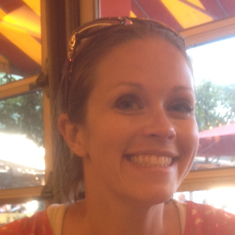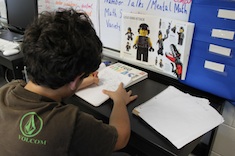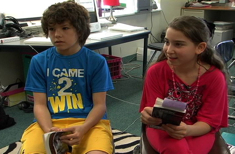This year, for the first time in my career, I taught teenagers—seventh graders whose reading, thanks to a looping arrangement, I’d been able to nurture the previous year. The heart of our time together in seventh grade was the same as in sixth grade; our independent reading practices honored choice, individual plans, reading communities, and time for reading.
This year, though, things felt different.
Some of my readers were in a high school credit course for the first time, many of them were in school sports for the first time, and most of them were increasingly tuned in to their social media in their free time.
All of my readers balanced more daunting academics than they had as sixth graders, and on the horizon loomed an eighth-grade schedule that would cut nearly a half hour from their language arts time. I discovered that even with all of the supports I had in place, my students were telling me more frequently that they hadn’t had time to read the previous night.
“Were YOU up with a toddler last night? Did YOU have to prepare dinner?” I prodded unhelpfully. “HOW ABOUT YOU LOG OUT OF INSTAGRAM!?”
My students sighed and mumbled, “. . . science fair . . . practice! . . . math exam . . . soooooooo buuuuusy. . . .”
The Power of Reading Habits
At the same time I took note of this trend, I was reading Charles Duhigg’s gem The Power of Habit. I’m drawn to these “popular psychology/economics”-type books (in the vein of Freakonomics, Outliers, and The Tipping Point, all of which have held truths about education for me). As I continued reading Duhigg’s work, my independent reading problem kept nagging me.
Duhigg’s work centers on the idea that each of our habits is formed by a loop of
1. cue—trigger to an action,
2. routine—the action, and
3. reward—the tangible or intangible end that makes us want to continue the habit.
Duhigg’s anecdotes were powerful and relatable. His analysis of his daily chocolate chip cookie habit? Spot on with my shameful dependence on our lunchroom’s giant cookies. That connection alone was powerful enough to draw my attention.
Carly and I decided to explore this idea of habits by starting with two weeks of baseline data collection; we told students that we were all studying our reading habits.
Each day for two weeks, every student collected his or her own data (we encouraged honesty!) and filled out a chart with the following information:
- What you read
- Where you read
- When you read
- How long you read
- How much you read
- How you felt after you read (that one made them giggle)
We continued about our typical independent reading routines—conferring, recommending, and celebrating our reading—and at the end of two weeks came together with our habits journals laid out in front of us and Charles Duhigg’s TED Talk on the screen.
“Now that you’ve noticed some patterns in your reading habits, we want you to pay close attention to this video. As you’re watching and taking notes, think about this guiding question: what on earth do these ideas about habits have to do with your habits as a reader?”
Students soaked up the TED Talk, the content of which runs the gamut from cookie resistance (I tried my best to listen) to experiments on rats to how habit formation informs the willpower training of Starbucks employees. (Teaching note: the Starbucks segment prominently features a “bad word” that made my 13-year-olds chuckle but should be skipped for younger students.)
“So, tell us more about what you noticed in the video,” I prompted them.
“I was surprised that even successful people sometimes can resist things,” Viraj responded. “Like it takes—What’s the word? Premeditating?—to keep a good habit going.”
I jotted down Viraj’s thoughts, noting that other students had nodded in agreement.
“I really connect with what you’re saying, Viraj. I consider myself to be a pretty enthusiastic and strong reader, but I also sometimes find myself having to be very thoughtful about fitting in time for reading,” I said, guiltily thinking about the nagging I’d frequently laid on my students.
I shared with my students how more “pressing” matters like planning, grading papers, preparing my children’s lunches, putting away laundry, and responding to emails sometimes ends up putting reading in the backseat. “Before I know it, it’s 10:30 p.m., and though I want to grab my book, I have to be up in six hours.
“How many of you have found yourselves struggling to fit in your reading time, either because you’re not excited to read, or because maybe you are excited to read, but you feel guilty not using the time to do other things you ‘should’ be doing?”
Hands shot up into the air.
Layering in Habit Talk
At that point, it was time to get direct. For the month of February we would be reestablishing our good reading habits. We wouldn’t let our nagging homework lists or busy practices get in the way of the reading time we really needed to protect for ourselves. We would all read at least 20 minutes every single day, no exceptions, to rewire ourselves.
“Knowing what you know about cues and rewards, and thinking about your own reading habits you studied the past two weeks, what are some of the cues you could establish to remind yourself to read?” Carly asked our students.
Carly started the list of cues with her own: keeping her independent reading book on her nightstand by her bed, or—brilliantly—under her pillow if it’s something she’s struggling with and needs an uncomfortable reminder.
Together we built this list of cues:
- book on nightstand
- book on pillow
- book anywhere I can see it
- set an alarm on my phone to remind myself
- put my backpack in my room
- just keep thinking about what I want to know next
- put after-school snack and book on my bedside
Students jotted down in a place of their choice the cues they would try. I admitted that my cue would involve hot chocolate and a couch away from my messy kitchen.
Though all students would have a standardized routine for February, we would gradually release them back to their own routines—choosing their days, times, and ways of tracking their reading.
We moved next to a list of rewards, a very adolescent mix of earnest (“finishing my book, and that in itself is a treat!”) and blunt (“earning time on my iPhone”). Carly and I decided that our rewards would be posting our progress on Goodreads, because it was satisfying and because that’s how we could share our recommendations with other readers.
A Month of New Habits: Permission to Read
During the month of February, we once again continued about our normal routines, but many of our small-group and individual conferences were framed within the context of habit.
In one conversation, Stacey mentioned something that showed us we needed to stay the course: ”I have been really busy with dance and science fair, so I haven’t been able to read as much as I’d like to, but now that science fair is done, I will hopefully be able to read more.”
The most challenging and eye-opening conversations were with my high-achieving students, who had become hyper-focused on their grades and projects and who felt that their independent reading—which most of them loved—was an indulgence they couldn’t afford.
Toward the end of the month, Bella told me in our conference, “I think I am reading better than before the study on habits because I am more conscientious about how I’m reading and the rewards/cues. My reward is having the satisfaction of knowing that I completed the reading assignment.”
Bella, an avid reader who had a new edgy YA book from the library every week and gleefully passed it on to her circle of friends, had left me a lot of room for thought about motivating passionate but thinly spread learners. Did they feel like they needed permission—for them, in the form of a mandate—to make reading a priority?
One of her friends, Allison, reflected, “I admit it: before this, I hadn’t read as much as I used to. I suppose (going forward) my cue could be that I’ve finished homework and/or have a lot of free time! My routine is to look at a clock, then read, read, read! I end up reading way longer than 20 minutes. My reward? I don’t really have one—I just like reading! I’m glad we started this because I’ve gotten back into reading. A lot!”
In our month of laser focus on reading habits, Carly, our readers, and I found that
- goals and action steps are great, but the real transformative power comes from turning bad habits into good ones, and strengthening good ones;
- our tenets of reading engagement and independent reading were still important with our young adolescent readers, maybe more so than ever;
- students read for all kinds of reasons;
- the habit focus had more students reading significantly more—more than the minimum we’d set—that month;
- a select group of high-achieving students benefited from a “mandate” to read;
- . . . but for most students, the richest reading is intrinsically motivated.
When it comes to my own habits, I still have a lot of room for growth. At the end of the school year, I still had not kicked my chocolate chip cookie habit—admittedly, I didn’t try very hard; those things are amazing—but, like my students, I’d become more intentional about my reading time. With the right cues and rewards, I’m learning to let go of the laundry, take a little longer to respond to my emails, and give myself permission to indulge my reading habit.







